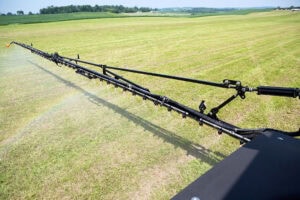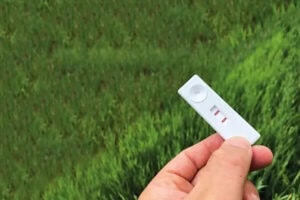Next generation weed management tools

Herbicide resistance is increasing globally, every year. Can new, genetics-based strategies for detecting and solving herbicide resistance help farmers keep the advantage?
Herbicides remain the most efficient method by which farmers can keep weeds at bay, but the number of chemical option available has not kept pace with the continued proliferation of herbicide resistant weed species – many of them exhibiting immunity to multiple modes of action.
During the 2021 Canadian Farm Writers’ Federation conference, researchers from Agriculture and Agri-Food Canada (AAFC), the nation’s federal farm and food ministry, detailed new genetics-based tools which could help farmers keep the advantage.
Rapid resistance identification

Canadian farmers collectively loose millions in revenue to weeds each year, even with effective chemical solutions, according to Robert Nurse, a research scientist based at AAFC’s most southerly research station in Harrow, Ontario.
Research from the ministry indicates weed related dips in profitability reach to 50 per cent yield losses from untreated weed pressure at the start of the growing season alone. Additional loses are subsequently added based on continued pressure as the season progresses. This stark reality is the reason for the now decades long, yet understandable, overreliance on herbicides, says Nurse.
Herbicide resistance is increasing globally, every year
Additional selection pressure resulting from repeated use of the same products in the same areas – an even more acute problem in crops where the number of registered herbicides is constrained – has only made things worse. “Herbicide resistance is increasing globally, every year,” he says. “This is not slowing down. The trend is upwards…If we look at Canada it’s the same trend.”
Also read: Detecting herbicide resistance
Coming from a geographical area on the frontline of herbicide resistant weed proliferation – many of which have and continue to creep northwards from the United States – Nurse says a major hurdle for growers is the inability to rapidly identify whether weeds in the field are or are not herbicide resistant.
Dose response approach
The method by which herbicide resistance has traditionally been identified involved “dose response” experiments – a lengthy process where specific plants are collected and subsequently treated with a range of herbicide doses in the lab. Cultivation and repeated testing are often part of the process as well.
Results from the dose response approach are difficult to determine before farmers have already made management decisions for the current or subsequent growing season. A grower could, for example, determine a different factor was responsible for the ineffectiveness of their previous herbicide application, and decide to stick with a product which will again not work. Conversely, they could switch products when sticking with the previous choice is more appropriate, or unnecessarily spend money on additional control measures.
Molecular marker test
For these reasons, Nurse and collaborating colleagues at other AAFC institutions developed a molecular marker test. The method looks for indicators in a plants DNA which indicate whether it has developed herbicide resistance to specific products or modes of action. Already available to some farmers, the idea is to make the rapid molecular resistance tests available to farmers across the country.
In-field resistance identification

AAFC’s rapid molecular test is reminiscent of other initiatives ongoing in other geographies, including efforts from United Kingdom researchers to develop tools for stemming black grass – a major problem weed across the British countryside.
Robert Edwards, professor of natural and environmental science at Newcastle University, helped develop the Black-grass REsistance Diagnostic tool (BReD) to meet farmer needs.
Inexpensive and specifically intended for in-field use, the tool is described as a “lateral-flow device” resembling a pregnancy test. Originally based on a (much more costly) tool used to identify fungal spores in the field, growers use the device by applying a leaf sample on the device. In five minutes, a series of red lines appear, the layout of which illustrate whether resistance genes are present.
By using it across the field, farmers can better map non-target-site herbicide resistant weed populations. Edwards adds it can help avoid the “classic control method” of flipping between different modes of action in herbicide applications, which he says actually hurts their chances of managing non-target resistance. “What we want is to eventually make a digital agronomist,” Edwards says.
dsRNA-based sprays
But what if weed control products did not rely on herbicide active ingredients in the first place? Martin Laforest, another AAFC scientist and a research colleague of Nurse, says harnessing the power of double-strand RNA (dsRNA) could prove highly effective.
dsRNA is a signal for the silencing of specific genes within organisms, including animal (insects), pathogens (fungus), and plants (weeds). Turning the right gene off via a dsRNA-based spray, says Laforest, can either kill the weed outright or make it once again susceptible to a product for which it had previously developed resistance.
RNA is highly sequence specific, so we should be able to target the weed
“We want to develop a spray which will kill the weed but leave the crop untouched, or not kill the weed and increase its susceptibility to the herbicide,” he says. “RNA is highly sequence specific, so we should be able to target the weed.”
When asked whether weeds could also develop resistance to dsRNA application, Laforest confirmed it is possible. However, he reiterates it would be quite easy tweak the design, thereby negating the weed’s newfound advantage. He adds some companies now under the Bayer banner had been experimenting with the technology on water hemp and palmer amaranth – two highly problematic weeds in North America – in 2013, though the technology has yet to be marketed.
Indeed, Laforest lists several challenges to getting dsRNA to market. For one, the design of each individual product has to be very target specific. dsRNA is also fragile, but has to penetrate the plant cell in order to work. Additional tools are thus required. The expense of producing a dsRNA compound is currently high, though he believes this could change with larger scale production.
Like any other product, dsRNA compounds must also be proven to have no off-target effects. Navigating the regulatory systems of individual political entities is yet another step to commercialization.
Join 17,000+ subscribers
Subscribe to our newsletter to stay updated about all the need-to-know content in the agricultural sector, two times a week.



